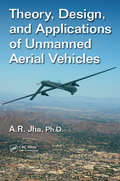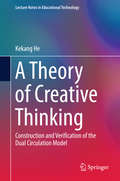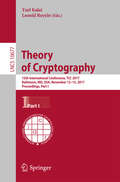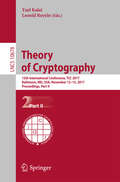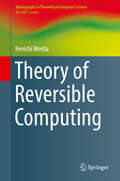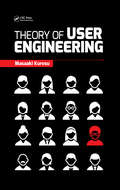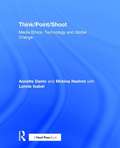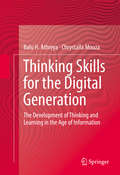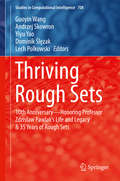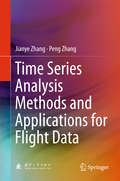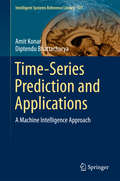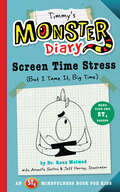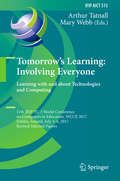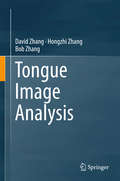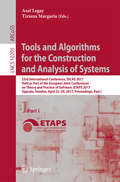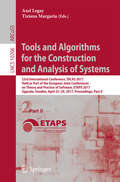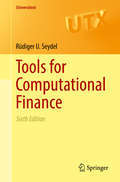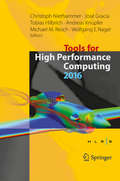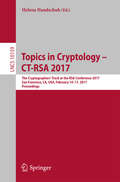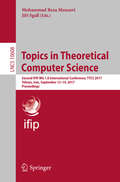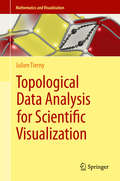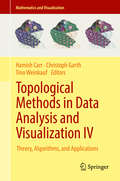- Table View
- List View
Theory, Design, and Applications of Unmanned Aerial Vehicles
by A. R. Jha, Ph.D.This book provides a complete overview of the theory, design, and applications of unmanned aerial vehicles. It covers the basics, including definitions, attributes, manned vs. unmanned, design considerations, life cycle costs, architecture, components, air vehicle, payload, communications, data link, and ground control stations. Chapters cover types and civilian roles, sensors and characteristics, alternative power, communications and data links, conceptual design, human machine interface, sense and avoid systems, civil airspace issues and integration efforts, navigation, autonomous control, swarming, and future capabilities.
Theory, Design, and Applications of Unmanned Aerial Vehicles
by A. R. Jha, Ph.D.This book provides a complete overview of the theory, design, and applications of unmanned aerial vehicles. It covers the basics, including definitions, attributes, manned vs. unmanned, design considerations, life cycle costs, architecture, components, air vehicle, payload, communications, data link, and ground control stations. Chapters cover types and civilian roles, sensors and characteristics, alternative power, communications and data links, conceptual design, human machine interface, sense and avoid systems, civil airspace issues and integration efforts, navigation, autonomous control, swarming, and future capabilities.
A Theory of Creative Thinking: Construction and Verification of the Dual Circulation Model (Lecture Notes in Educational Technology)
by Kekang HeThis book examines research on creative thinking, both current and historical. It explores two dimensions of human thought (time and space) and two modes of thinking (conscious and unconscious) as well as both left and right brain functions and artistic and scientific creative activities. The book proposes a "Double Circulation” model of creative thinking and argues that imagery thinking, intuitive thinking and logical thinking are main parts of creative thinking and that dialectical thinking and horizontal-vertical thinking are the guides for highly complex problem-solving thoughts and strategies.The book focuses on education and psychology and also covers how to use ICT to promote students’ creative thinking skills.Researchers will benefit from the "Double Circulation" model, which provides a new perspective on conducting creative thinking research. The book is also a valuable resource for graduate students in the fields of educational technology and psychology and for all readers who are interested in creative thinking.
Theory of Cryptography: 15th International Conference, TCC 2017, Baltimore, MD, USA, November 12-15, 2017, Proceedings, Part I (Lecture Notes in Computer Science #10677)
by Yael Kalai Leonid ReyzinThe two-volume set LNCS 10677 and LNCS 10678 constitutes the refereed proceedings of the 15th International Conference on Theory of Cryptography, TCC 2017, held in Baltimore, MD, USA, in November 2017.The total of 51 revised full papers presented in the proceedings were carefully reviewed and selected from 150 submissions. The Theory of Cryptography Conference deals with the paradigms, approaches, and techniques used to conceptualize natural cryptographic problems and provide algorithmic solutions to them and much more.
Theory of Cryptography: 15th International Conference, TCC 2017, Baltimore, MD, USA, November 12-15, 2017, Proceedings, Part II (Lecture Notes in Computer Science #10678)
by Yael Kalai Leonid ReyzinThe two-volume set LNCS 10677 and LNCS 10678 constitutes the refereed proceedings of the 15th International Conference on Theory of Cryptography, TCC 2017, held in Baltimore, MD, USA, in November 2017.The total of 51 revised full papers presented in the proceedings were carefully reviewed and selected from 150 submissions. The Theory of Cryptography Conference deals with the paradigms, approaches, and techniques used to conceptualize natural cryptographic problems and provide algorithmic solutions to them and much more.
Theory of Reversible Computing (Monographs in Theoretical Computer Science. An EATCS Series)
by Kenichi MoritaThis book describes reversible computing from the standpoint of the theory of automata and computing. It investigates how reversibility can be effectively utilized in computing. A reversible computing system is a “backward deterministic” system such that every state of the system has at most one predecessor. Although its definition is very simple, it is closely related to physical reversibility, one of the fundamental microscopic laws of Nature. Authored by the leading scientist on the subject, this book serves as a valuable reference work for anyone working in reversible computation or in automata theory in general. This work deals with various reversible computing models at several different levels, which range from the microscopic to the macroscopic, and aims to clarify how computation can be carried out efficiently and elegantly in these reversible computing models. Because the construction methods are often unique and different from those in the traditional methods, these computing models as well as the design methods provide new insights for future computing systems. Organized bottom-up, the book starts with the lowest scale of reversible logic elements and circuits made from them. This is followed by reversible Turing machines, the most basic computationally universal machines, and some other types of reversible automata such as reversible multi-head automata and reversible counter machines. The text concludes with reversible cellular automata for massively parallel spatiotemporal computation. In order to help the reader have a clear understanding of each model, the presentations of all different models follow a similar pattern: the model is given in full detail, a short informal discussion is held on the role of different elements of the model, and an example with illustrations follows each model.
Theory of User Engineering
by Masaaki KurosuThis book outlines the new concept of user engineering and covers the diversity of users, along with the business process that includes the design and the user’s experience processes. Although the concept of user experience (UX) has become popular, the definition and the methodology are still ambiguous. User engineering is similar to the user-centered design, but differs in that its scope is not limited to the design process but concerns the whole manufacturing process and the whole usage process, i.e., the whole lifecycle of an artifact. User’s perspective is strongly emphasized in this book, hence, its stance is far from that of the marketing approach that usually fails to notice the life and experiences of users after the purchase of an artifact as consumers. Theory of User Engineering differentiates between the quality in design and the quality in use, and the objective quality characteristics and the subjective quality characteristics. In addition to the user research using ethnographic methods, the author introduces a new approach based on the artifact evolution theory that can be adopted in the planning stage.
Theory of User Engineering
by Masaaki KurosuThis book outlines the new concept of user engineering and covers the diversity of users, along with the business process that includes the design and the user’s experience processes. Although the concept of user experience (UX) has become popular, the definition and the methodology are still ambiguous. User engineering is similar to the user-centered design, but differs in that its scope is not limited to the design process but concerns the whole manufacturing process and the whole usage process, i.e., the whole lifecycle of an artifact. User’s perspective is strongly emphasized in this book, hence, its stance is far from that of the marketing approach that usually fails to notice the life and experiences of users after the purchase of an artifact as consumers. Theory of User Engineering differentiates between the quality in design and the quality in use, and the objective quality characteristics and the subjective quality characteristics. In addition to the user research using ethnographic methods, the author introduces a new approach based on the artifact evolution theory that can be adopted in the planning stage.
Think/point/shoot: Media Ethics, Technology And Global Change (PDF)
by Annette Danto Mobina Hashmi Lonnie IsabelThink/Point/Shoot gives students a thorough overview of the role of ethics in modern media creation. Case studies emphasize the critical issues in global media ethics today in all stages of media creation from preproduction research and development, to production and post production. This volume features practicing filmmakers, journalists, and media creators who provide insight into dealing with real-world ethical dilemmas. For this era, digital imagery, sounds, and web communication have opened doors to sharing thoughts and ideas instantaneously to potentially vast audiences. This presents exciting opportunities, but also serious ethical, legal, and social challenges. The cases and exercises found in this book are applicable to the current media field while still remaining grounded in strong ethical theory. Think/Point/Shoot explains the challenge of communicating a story to a worldwide audience while maintaining ethical standards. A companion website provides additional resources for students and instructors: media ethics game chapter summaries and case studies important forms Instructors will also find: classroom exercises PowerPoints video from the "Global Media Ethics" Conference from March 2013
Think/point/shoot: Media Ethics, Technology And Global Change
by Annette Danto Mobina Hashmi Lonnie IsabelThink/Point/Shoot gives students a thorough overview of the role of ethics in modern media creation. Case studies emphasize the critical issues in global media ethics today in all stages of media creation from preproduction research and development, to production and post production. This volume features practicing filmmakers, journalists, and media creators who provide insight into dealing with real-world ethical dilemmas. For this era, digital imagery, sounds, and web communication have opened doors to sharing thoughts and ideas instantaneously to potentially vast audiences. This presents exciting opportunities, but also serious ethical, legal, and social challenges. The cases and exercises found in this book are applicable to the current media field while still remaining grounded in strong ethical theory. Think/Point/Shoot explains the challenge of communicating a story to a worldwide audience while maintaining ethical standards. A companion website provides additional resources for students and instructors: media ethics game chapter summaries and case studies important forms Instructors will also find: classroom exercises PowerPoints video from the "Global Media Ethics" Conference from March 2013
Thinking Skills for the Digital Generation: The Development of Thinking and Learning in the Age of Information
by Balu H. Athreya Chrystalla MouzaThis important text synthesizes the state of knowledge related to thinking and technology and provides strategies for helping young people cultivate thinking skills required to navigate the new digital landscape. The rise of technology has resulted in new ways of searching and communicating information among youth, often creating information “overload”. We do not know how the new technologies will affect the ways young people learn and think. There are plenty of warnings about the dangers of information technology, but there is also enormous potential for technology to aid human thinking, which this book explores from an open-minded perspective.Coverage Includes:- An up to date review of the literature on thinking skills in general, and in relation to technology.- Practical guidelines for thinking with technology.- A scholarly review of the characteristics of the digital generation.- A discussion of the various steps involved in the thinking process.- A historical context of the Information Age and the transition from oral history, to printing press, to the Internet.Thinking Skills for the Digital Generation: The Development of Thinking and Learning in the Age of Information is an invaluable reference for educators and research professionals particularly interested in educational technology, and improving thinking and problem-solving skills.
Thriving Rough Sets: 10th Anniversary - Honoring Professor Zdzisław Pawlak's Life and Legacy & 35 Years of Rough Sets (Studies in Computational Intelligence #708)
by Guoyin Wang Andrzej Skowron Yiyu Yao Dominik Ślęzak Lech PolkowskiThis special book is dedicated to the memory of Professor Zdzisław Pawlak, the father of rough set theory, in order to commemorate both the 10th anniversary of his passing and 35 years of rough set theory. The book consists of 20 chapters distributed into four sections, which focus in turn on a historical review of Professor Zdzisław Pawlak and rough set theory; a review of the theory of rough sets; the state of the art of rough set theory; and major developments in rough set based data mining approaches. Apart from Professor Pawlak’s contributions to rough set theory, other areas he was interested in are also included. Moreover, recent theoretical studies and advances in applications are also presented. The book will offer a useful guide for researchers in Knowledge Engineering and Data Mining by suggesting new approaches to solving the problems they encounter.
Time Series Analysis Methods and Applications for Flight Data
by Jianye Zhang Peng ZhangThis book focuses on different facets of flight data analysis, including the basic goals, methods, and implementation techniques. As mass flight data possesses the typical characteristics of time series, the time series analysis methods and their application for flight data have been illustrated from several aspects, such as data filtering, data extension, feature optimization, similarity search, trend monitoring, fault diagnosis, and parameter prediction, etc. An intelligent information-processing platform for flight data has been established to assist in aircraft condition monitoring, training evaluation and scientific maintenance. The book will serve as a reference resource for people working in aviation management and maintenance, as well as researchers and engineers in the fields of data analysis and data mining.
Time-Series Prediction and Applications: A Machine Intelligence Approach (Intelligent Systems Reference Library #127)
by Amit Konar Diptendu BhattacharyaThis book presents machine learning and type-2 fuzzy sets for the prediction of time-series with a particular focus on business forecasting applications. It also proposes new uncertainty management techniques in an economic time-series using type-2 fuzzy sets for prediction of the time-series at a given time point from its preceding value in fluctuating business environments. It employs machine learning to determine repetitively occurring similar structural patterns in the time-series and uses stochastic automaton to predict the most probabilistic structure at a given partition of the time-series. Such predictions help in determining probabilistic moves in a stock index time-series Primarily written for graduate students and researchers in computer science, the book is equally useful for researchers/professionals in business intelligence and stock index prediction. A background of undergraduate level mathematics is presumed, although not mandatory, for most of the sections. Exercises with tips are provided at the end of each chapter to the readers’ ability and understanding of the topics covered.
Timmy's Monster Diary: Screen Time Stress (But I Tame It, Big Time) (Monster Diaries #2)
by Raun Melmed Annette SextonUsing the "Time-Telling" and "ST4" techniques developed by Dr. Raun Melmed of the Melmed Center in Arizona, Timmy's Monster Diary teaches kids how to self-moniter the amount of time they spend on technology.
Tomorrow's Learning: 11th IFIP TC 3 World Conference on Computers in Education, WCCE 2017, Dublin, Ireland, July 3-6, 2017, Revised Selected Papers (IFIP Advances in Information and Communication Technology #515)
by Arthur Tatnall Mary WebbThis book constitutes the refereed post-conference proceedings of the 11th IFIP TC 3 World Conference on Computers in Education, WCCE 2017, held in Dublin, Ireland, in July 2017.The 57 revised full papers and 10 short papers were carefully reviewed and selected from 116 submissions during two rounds of reviewing and improvement. The papers are organized in the following topical sections: futures of technology for learning and education; innovative practices with learning technologies; and computer science education and its future focus and development. Also included is "The Dublin Declaration" which identifies key aspects of innovation, development successes, concerns and interests in relation to ICT and education.
Tongue Image Analysis
by David Zhang Hongzhi Zhang Bob ZhangThis is the first book offering a systematic description of tongue image analysis and processing technologies and their typical applications in computerized tongue diagnostic (CTD) systems. It features the most current research findings in all aspects of tongue image acquisition, preprocessing, classification, and diagnostic support methodologies, from theoretical and algorithmic problems to prototype design and development of CTD systems. The book begins with a very in-depth description of CTD on a need-to-know basis which includes an overview of CTD systems and traditional Chinese medicine (TCM) in order to provide the information on the context and background of tongue image analysis. The core part then introduces algorithms as well as their implementation methods, at a know-how level, including image segmentation methods, chromatic correction, and classification of tongue images. Some clinical applications based on these methods are presented for the show-how purpose in the CTD research field. Case studies highlight different techniques that have been adopted to assist the visual inspection of appendicitis, diabetes, and other common diseases. Experimental results under different challenging clinical circumstances have demonstrated the superior performance of these techniques. In this book, the principles of tongue image analysis are illustrated with plentiful graphs, tables, and practical experiments to provide insights into some of the problems. In this way, readers can easily find a quick and systematic way through the complicated theories and they can later even extend their studies to special topics of interest. This book will be of benefit to researchers, professionals, and graduate students working in the field of computer vision, pattern recognition, clinical practice, and TCM, as well as those involved in interdisciplinary research.
Tools and Algorithms for the Construction and Analysis of Systems: 23rd International Conference, TACAS 2017, Held as Part of the European Joint Conferences on Theory and Practice of Software, ETAPS 2017, Uppsala, Sweden, April 22-29, 2017, Proceedings, Part I (Lecture Notes in Computer Science #10205)
by Axel Legay Tiziana MargariaThe two-book set LNCS 10205 + 10206 constitutes the proceedings of the 23rd International Conference on Tools and Algorithms for the Construction and Analysis of Systems, TACAS 2017, which took place in Uppsala, Sweden in April 2017, held as Part of the European Joint Conferences on Theory and Practice of Software, ETAPS 2017.The 48 full papers, 4 tool demonstration papers, and 12 software competition papers presented in these volumes were carefully reviewed and selected from 181 submissions to TACAS and 32 submissions to the software competition. They were organized in topical sections named: verification techniques; learning; synthesis; automata; concurrency and bisimulation; hybrid systems; security; run-time verification and logic; quantitative systems; SAT and SMT; and SV COMP.
Tools and Algorithms for the Construction and Analysis of Systems: 23rd International Conference, TACAS 2017, Held as Part of the European Joint Conferences on Theory and Practice of Software, ETAPS 2017, Uppsala, Sweden, April 22-29, 2017, Proceedings, Part II (Lecture Notes in Computer Science #10206)
by Axel Legay Tiziana MargariaThe two-book set LNCS 10205 + 10206 constitutes the proceedings of the 23rd International Conference on Tools and Algorithms for the Construction and Analysis of Systems, TACAS 2017, which took place in Uppsala, Sweden in April 2017, held as Part of the European Joint Conferences on Theory and Practice of Software, ETAPS 2017.The 48 full papers, 4 tool demonstration papers, and 12 software competition papers presented in these volumes were carefully reviewed and selected from 181 submissions to TACAS and 32 submissions to the software competition. They were organized in topical sections named: verification techniques; learning; synthesis; automata; concurrency and bisimulation; hybrid systems; security; run-time verification and logic; quantitative systems; SAT and SMT; and SV COMP.
Tools for Computational Finance (Universitext)
by Rüdiger U. SeydelComputational and numerical methods are used in a number of ways across the field of finance. It is the aim of this book to explain how such methods work in financial engineering. By concentrating on the field of option pricing, a core task of financial engineering and risk analysis, this book explores a wide range of computational tools in a coherent and focused manner and will be of use to anyone working in computational finance. Starting with an introductory chapter that presents the financial and stochastic background, the book goes on to detail computational methods using both stochastic and deterministic approaches.Now in its sixth edition, Tools for Computational Finance has been significantly revised and contains: Several new parts such as a section on extended applications of tree methods, including multidimensional trees, trinomial trees, and the handling of dividends;Additional material in the field of generating normal variates with acceptance-rejection methods, and on Monte Carlo methods;115 exercises, and more than 100 figures, many in color.Written from the perspective of an applied mathematician, all methods are introduced for immediate and straightforward application. A ‘learning by calculating’ approach is adopted throughout this book, enabling readers to explore several areas of the financial world.Interdisciplinary in nature, this book will appeal to advanced undergraduate and graduate students in mathematics, engineering, and other scientific disciplines as well as professionals in financial engineering.
Tools for High Performance Computing 2016: Proceedings of the 10th International Workshop on Parallel Tools for High Performance Computing, October 2016, Stuttgart, Germany
by Christoph Niethammer José Gracia Tobias Hilbrich Andreas Knüpfer Michael M. Resch Wolfgang E. NagelThis book presents the proceedings of the 10th International Parallel Tools Workshop, held October 4-5, 2016 in Stuttgart, Germany – a forum to discuss the latest advances in parallel tools.High-performance computing plays an increasingly important role for numerical simulation and modelling in academic and industrial research. At the same time, using large-scale parallel systems efficiently is becoming more difficult. A number of tools addressing parallel program development and analysis have emerged from the high-performance computing community over the last decade, and what may have started as collection of small helper script has now matured to production-grade frameworks. Powerful user interfaces and an extensive body of documentation allow easy usage by non-specialists.
Topics in Cryptology – CT-RSA 2017: The Cryptographers’ Track at the RSA Conference 2017, San Francisco, CA, USA, February 14–17, 2017, Proceedings (Lecture Notes in Computer Science #10159)
by Helena HandschuhThis book constitutes the refereed proceedings of the Cryptographer's Track at the RSA Conference 2017, CT-RSA 2017, held in San Francisco, CA, USA, in February 2017.The 25 papers presented in this volume were carefully reviewed and selected from 77 submissions.CT-RSA has become a major publication venue in cryptography. It covers a wide variety of topics from public-key to symmetric key cryptography and from cryptographic protocols to primitives and their implementation security. This year selected topics such as cryptocurrencies and white-box cryptography were added to the call for papers.
Topics in Theoretical Computer Science: Second IFIP WG 1.8 International Conference, TTCS 2017, Tehran, Iran, September 12-14, 2017, Proceedings (Lecture Notes in Computer Science #10608)
by Mohammad Reza Mousavi Jiří SgallThis book constitutes the refereed proceedings of the Second IFIP WG 1.8 International Conference on Topics in Theoretical Computer Science, TTCS 2017, held in Tehran, Iran, in September 2017. The 8 papers presented in this volume were carefully reviewed and selected from 20 submissions. They were organized in topical sections named: algorithms and complexity; and logic, semantics, and programming theory.
Topological Data Analysis for Scientific Visualization (Mathematics and Visualization)
by Julien TiernyCombining theoretical and practical aspects of topology, this book provides a comprehensive and self-contained introduction to topological methods for the analysis and visualization of scientific data.Theoretical concepts are presented in a painstaking but intuitive manner, with numerous high-quality color illustrations. Key algorithms for the computation and simplification of topological data representations are described in detail, and their application is carefully demonstrated in a chapter dedicated to concrete use cases.With its fine balance between theory and practice, "Topological Data Analysis for Scientific Visualization" constitutes an appealing introduction to the increasingly important topic of topological data analysis for lecturers, students and researchers.
Topological Methods in Data Analysis and Visualization IV: Theory, Algorithms, and Applications (Mathematics and Visualization)
by Hamish Carr Christoph Garth Tino WeinkaufThis book presents contributions on topics ranging from novel applications of topological analysis for particular problems, through studies of the effectiveness of modern topological methods, algorithmic improvements on existing methods, and parallel computation of topological structures, all the way to mathematical topologies not previously applied to data analysis. Topological methods are broadly recognized as valuable tools for analyzing the ever-increasing flood of data generated by simulation or acquisition. This is particularly the case in scientific visualization, where the data sets have long since surpassed the ability of the human mind to absorb every single byte of data. The biannual TopoInVis workshop has supported researchers in this area for a decade, and continues to serve as a vital forum for the presentation and discussion of novel results in applications in the area, creating a platform to disseminate knowledge about such implementations throughout and beyond the community. The present volume, resulting from the 2015 TopoInVis workshop held in Annweiler, Germany, will appeal to researchers in the fields of scientific visualization and mathematics, domain scientists with an interest in advanced visualization methods, and developers of visualization software systems.
